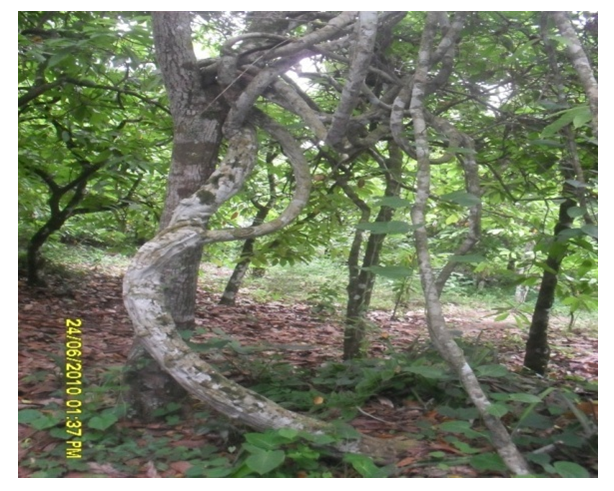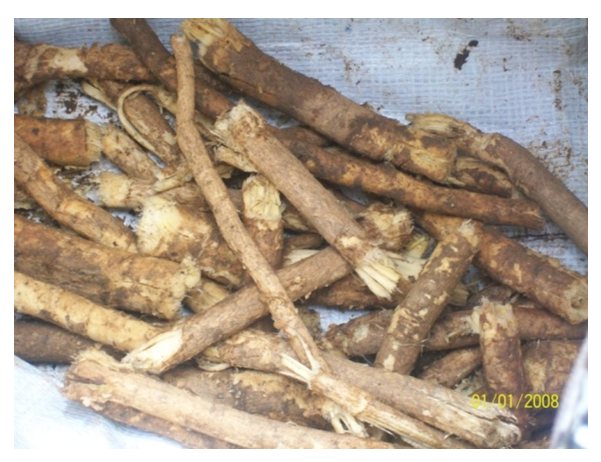-
Paper Information
- Paper Submission
-
Journal Information
- About This Journal
- Editorial Board
- Current Issue
- Archive
- Author Guidelines
- Contact Us
Advances in Analytical Chemistry
p-ISSN: 2163-2839 e-ISSN: 2163-2847
2020; 10(1): 11-13
doi:10.5923/j.aac.20201001.03
Received: July 8, 2020; Accepted: July 25, 2020; Published: August 15, 2020

Chemical Compositions of Plukenetia conophora Mull. Arg. Root Bark Crude Oil Extract
Ayoola P. B. 1, Akintola A. O. 1, Odeniyi M. A. 1, Faboya O. O. P. 2, Onawumi O. O. E. 2
1Department of Science Laboratory Technology, Ladoke Akintola University of Technology, Ogbomoso, Oyo State, Nigeria
2Department of Pure and Applied Chemistry, Ladoke Akintola University of Technology, Ogbomoso, Oyo State, Nigeria
Correspondence to: Onawumi O. O. E. , Department of Pure and Applied Chemistry, Ladoke Akintola University of Technology, Ogbomoso, Oyo State, Nigeria.
| Email: |  |
Copyright © 2020 The Author(s). Published by Scientific & Academic Publishing.
This work is licensed under the Creative Commons Attribution International License (CC BY).
http://creativecommons.org/licenses/by/4.0/

The crude oil extract from the root bark of Plukenetia conophora Mull.arg plant was analyzed for their constituents by means of gas chromatography and gas chromatography coupled with mass spectrometry. Fourteen compounds were identified in the root bark oil. The most abundant compounds in the oil were 11, 14-octadecadienoic acid (41.20%) and palmitic acid (26.46%), while the less abundant compounds were; stearic acid (8.07%) and triacontanoic acid (3.42%). The characteristic of this oil is the presence of long chain fatty acids.
Keywords: Plukenetia conophora, Root bark, Crude oil, Extract, GC and GC-MS
Cite this paper: Ayoola P. B. , Akintola A. O. , Odeniyi M. A. , Faboya O. O. P. , Onawumi O. O. E. , Chemical Compositions of Plukenetia conophora Mull. Arg. Root Bark Crude Oil Extract, Advances in Analytical Chemistry, Vol. 10 No. 1, 2020, pp. 11-13. doi: 10.5923/j.aac.20201001.03.
Article Outline
1. Introduction
- Many people are now turning to natural products in order to prevent, treat diseases or maintain good health. Recent research reports had shown the potential of health benefits of essential fatty acids (EFAs). As a result of this, consumers should be aware of the role EFAs play in nutrition, health and disease, in order to take good care of their health. Essential fatty acids, or EFAs, are fatty acids that humans and other animals must ingest because the body requires them for good health but cannot synthesize them (Robert and Maurice, 1980). These EFAs are part of vegetable oil constituents examples of EFAs are alpha-linolenic acid (an omega-3 fatty acid) and linoleic acid (an omega-6 fatty acid), while essential oils are concentrated hydrophobic liquid containing volatile aroma compounds from plants. The essentiality of the oil does not indicate indispensable as in essential amino acids or essential fatty acids which indicates nutritional requirement by a living organism (Reeds, 2000).Essential oils are generally extracted by solvent extraction (maceration), absolute oil extraction, distillation and cold pressing; they are used in perfumes, cosmetics, soaps, food and drinks as flavour. Also used in the treatment of skin diseases and as remedy for cancer (Thorpe’s, 1947).Plukenetia conophora, is a woody perennial climber belongs to the family of Euphorbiaceae. Its common name is African walnut and it is widely distributed in the Southern part of Nigeria. It is known in the Southern Nigeria as ukpa (Igbo), Western Nigeria as awusa or asala (Yoruba). This plant is cultivated principally for the nuts which are cooked and consumed as snacks (Oke, 1995). The work done by Oyenuga (1997) revealed the presence of amino acid and fatty acid components of the nut and the use of its leaf juice for the treatment of prolonged and constant hiccups. Ayoola et al., (2011) reported the phytochemical and nutrient evaluation of the African walnut root. The root bark of this plant has been in use for many years to treat and prevent different ailment but little work or no work has been reported on the essential oils of the Plukenetia conophora root bark. Therefore, the objective of this research work is to evaluate the chemical compositions of the crude oil extract of Plukenetia conophora root bark in order to ascertain its possible usefulness as cosmetics and in formulation of drugs.
2. Materials and Methods
2.1. Plant Material
- The Plukenetia conophora fresh root bark (Plate 2) was collected at Oshu village in Oko area, Alagbayen farm, Surulere Local Government Area of Oyo State, Nigeria. The root bark was washed, cut into small pieces to facilitate dryness, and air-dried for 14 days. The dried sample was ground into fine powder and stored in an air tight bottle put in the desiccators prior to analysis.
 | Plate 1. Plukenetia conophora plant shows as a climber tree (Source: Ayoola et al., 2011) |
 | Plate 2. Root Plukenetia conophora (Source: Onawumi et al., 2015) |
2.2. Isolation of Essential Oils
- The powdered root bark sample was weighed (50 g) into a 2.5 L bottle where 1.5 L of n-hexane was introduced and the mixture was left for 72 h with intermittent shaking (extraction by maceration). The mixture was filtered using glass wool in funnel and the filtrate was left to evaporate all the n-hexane.
2.3. Gas Chromatography
- The crude oil extract was subjected to GC analyses on GC 2010 gas chromatograph. Column oven temperature is 60°C injection temperature of 250°C, split injection mode, at 100, 2k Pa; Column flow of 1.61 ml/min and total flow of 6.2 ml/min; 1.0 split ratio; oven temperature programming is 60°C (for 5 mins.) and at the rate of 5°C / min till 140°C, 15 °/min till 280°C.
2.4. Gas Chromatography-Mass Spectrometry
- The GC-MS analyses were performed on GC-MS QP2010 Plus ion, Source temperature 200°C; interface temperature 250°C; solvent cut time 2.5 min; with relative detector gain mode and threshold 3000; scan MS ACQ mode; detector FTD; mass range of m/z 40-400.
2.5. Identification of Components
- Identification of the extracted oil components were based on their retention indices (determined with a reference to a homologous series of n-alkanes), along with comparison of their mass spectral fragmentation patterns in computer matching against in built data and commercials such as Joulain and Koenia (1998), Adams (1995) and massada (1976) Libraries as well as in-house “Baser Library of Essential oil constituents” built up by genuine compounds and components of known oils.
3. Results and Discussion
- The root bark crude oil extrac was analyzed for its constituents by means of gas chromatography (GC) and gas chromatography coupled with mass spectrometry (GC-MS).Fourteen compounds were identified in the root bark which is respectively responsible for the root bark 11.4% oil yielded (Table 1).
|
|
4. Conclusions
- Chemical composition of the crude oil extract of P.conophora fresh root bark which is normally known for it’s used in some traditional healing homes as medicaments consists of compounds that are health friendly.
ACKNOWLEDGEMENTS
- We acknowledge the assistance of G.C. Adeyinka who linked us to NARICT, Zaria making possible the GC and GC-MS analyses. Prof. A.T.J. Ogunkunle of Pure and Applied Biology Dept. LAUTECH, Ogbomoso, who assisted in the botanical name of the plant. We also appreciate the role played by Mrs. M.A. Ayoola for typing the manuscript.
 Abstract
Abstract Reference
Reference Full-Text PDF
Full-Text PDF Full-text HTML
Full-text HTML
